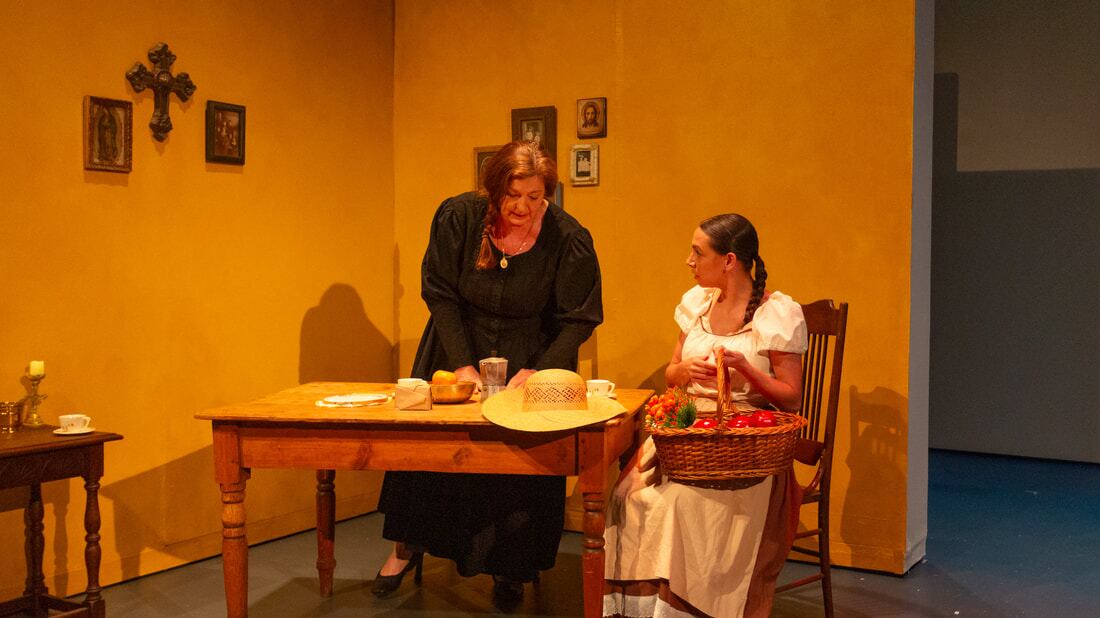A headless dress form looms behind two rooms. That’s what audiences see at the beginning of Shaking the Tree Theatre’s production of Blood Wedding. On the dress form is a long gown that seems to be made of white roses and blood-red trim. Its “arms”—two horizontal poles that are also tipped with red—suggest severed hands.
This tableau comes not from the playwright, Federico García Lorca, but from the imagination of director/set designer Samantha Van Der Merwe, whose creative genius immerses us in Lorca’s themes of forbidden love, fate and repression.
Lorca’s poetic script (translated from Spanish by Jo Clifford) pulses with vivid images as well as lush language that rhythmically repeats like waves in the ocean. By also weaving in numerous songs, the play leads audiences into the realm of a dark fantasy, with sleeping flowers and a weeping horse and a vision of impending death, which Van Der Merwe’s production makes as palpable as the velvet petals and pointed thorns of a rose.
First performed in 1933 in Madrid, the folkloric Blood Wedding tells the story of two men (the Bridegroom and Leonardo) who desire the same woman. Van Der Merwe depicts their rivalry by setting the Bridegroom (Rocco Weyer) in a golden room where he plays his guitar. As the music reaches a crescendo, the passionate Leonardo (Orlando Reyes Cabrera), who’s sitting statue-still in an opposing reddish-brown room, suddenly jumps up and charges offstage. The surprising violence of his movement is a potent symbol of his frustrated desire for the Bride (Olivia Mathews), his former love who’s engaged to marry the Bridegroom.
Although Lorca’s script is peppered with detailed stage directions, such as the colors of the rooms, Van Der Merwe has added her own touches, like the dress form, which symbolizes the duality of a woman’s role in provincial Spanish society. The ability to attract men is a form of power, but after marriage, it’s the husbands who make the decisions and the money, leaving the wives to play subservient roles generation after generation.
That cycle is embodied by a scene where Leonardo’s Wife (Sammy Rat Rios) and her mother (Marilyn Stacey), who’s simply called “Mother-in-Law,” sing with sorrowfully sweet voices, trying to lull the Wife’s baby son to sleep, only to have Leonardo later wake the infant by shouting at his wife to shut up. The Wife and the Mother-in-Law, who are both dressed in drab sage-green garb (designed by Paige A. Hanna), then resignedly resume their sad lullaby while Leonardo takes off on his horse.
Like the characters in Blood Wedding who constantly tell others to be quiet, Lorca, a gay man living in socially conservative 1930s Spain, had to hide his sexuality to avoid persecution. It’s telling that he wrote about the plight of women like the Bride, who survives by keeping her fiery eyes down and her hands clasped and is then praised by other characters, not for her talents, but for being a “good girl.”
Since she’s a woman, even her feelings are not her own, as her father (a deceptively jovial Bobby Bermea) makes clear. While negotiating her marriage like a juicy business deal, he commands his daughter to look happy about it.
The Bride’s true desires, though, can’t be ordered away. When she and Leonardo run away together on his horse, the play explodes into action. Weyer, who has until now worn an impossibly cheerful and perpetual smile as the Bridegroom, transforms into a ravenous tiger ready to pounce on his prey, summoning a passion that’s equal to or perhaps even surpasses that of Reyes Cabrera’s Leonardo.
Soon, characters are beckoning each other to take up the chase—and then they beg us, the audience, to “Follow the lanterns!” and join the hunt. This bold turn was so unexpected that my theater companion and I nearly laughed with delight. Later, though, the meaning of it took on another layer. Were we, the audience, playing a part in a tragedy that ultimately leaves two fictional characters dead? Was the production inviting us to ask if we’re participants in a repressive and punitive society…not just in the play, but in our real lives?
In the second act, Blood Wedding becomes increasingly imagistic, as three silver-faced woodcutters wielding axes walk through a gray forest with slow, dreamlike movements, and a Beggarwoman (Jacqueline MacDonald) with long blackened fingers represents death. Like the entire production, the concluding scenes unleash Van Der Merwe’s poetic artistry, deftly making Lorca’s classic tragedy bloom with thrilling and dangerous life.
SEE IT: Blood Wedding plays at Shaking the Tree Theatre, 823 SE Grant St., 503-235-0635, shaking-the-tree.com. 7:30 pm Thursday–Saturday, 5 pm Sunday, through Nov. 11. $10-$45.
